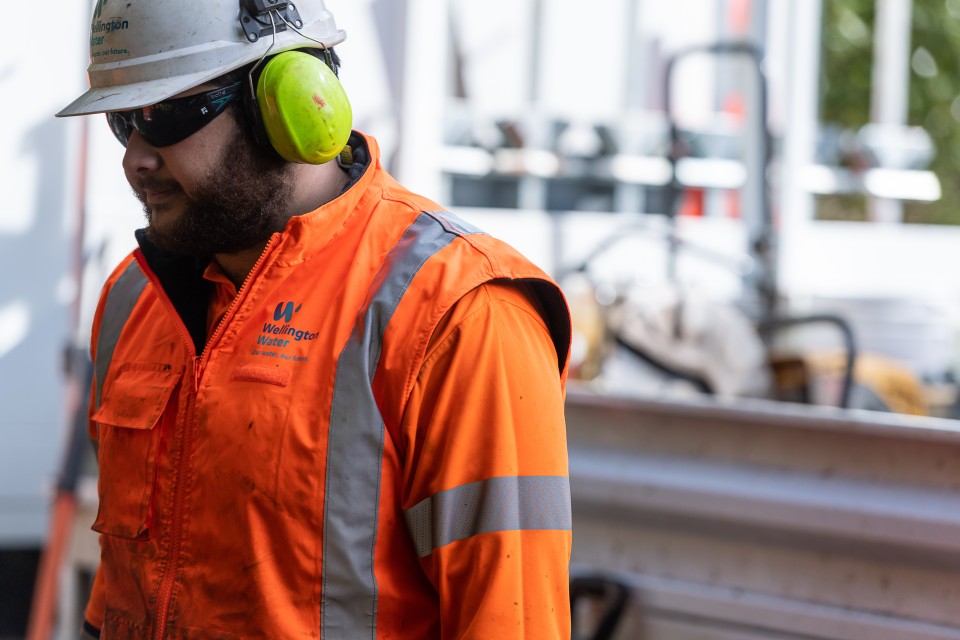Network Overflows
Wellington region’s wastewater system is ageing, and parts of the network are over 120 years. When the wastewater network was originally constructed, it was designed around protecting public health, with less focus on the health of the environment.
The network transfers as much as it physically can to treatment plants, up to five times the normal daily average flows. However, when the network gets overloaded, some wastewater can overflow from manhole lids and at constructed outlet pipes into streams, rivers, and the harbour. These overflows, minimise the risk of wastewater entering your property and community and reduce the risks to public health.
Overflows also happen where stormwater pipes are incorrectly connected to a wastewater pipe. These cross connections can cause the wastewater network to overflow during heavy rainfall, spilling untreated wastewater into the environment.
Wellington Water recommends all recreational water users follow the advice of Land, Air, Water Aotearoa (LAWA).
What we are doing to reduce network overflows
In partnership with our client councils, mana whenua iwi, and through community input, we are taking a catchment-wide approach to identify and address network overflows and reduce the impact on the environment where we can. This new approach follows resource consents that were recently lodged with Greater Wellington Regional Council.
Throughout the region, our council owners are investing in multi-million-dollar projects such as the Porirua Central Wastewater Storage Tank currently under construction. In the Wellington CBD, we are increasing network capacity, while in the Hutt Valley, we are increasing the resilience of the wastewater network with a variety of projects. In addition, Wellington Water is also inspecting property connections to reduce the source of wet weather overloading.
Read our Wastewater page to find out what you can do to prevent wastewater overflows and help take care of the region’s wastewater network and protect the environment.
Network Overflows Reporting
Where we can, we report overflows from the wastewater network during heavy rainfall on a monthly basis.
The data provided below reflects network overflows recorded at selected and monitored sites across the Wellington metropolitan region only. They are not representative of all network overflows during wet weather events.
We are working on providing the public with further data on overflows, which will require additional resources to verify the accuracy of this information before we can publish it.
We acknowledge these events are of public interest. We are committed to being open and transparent in letting you know when they occur. We are working to improve our systems for the reporting of all network overflows and to ensure the data accuracy and integrity for more comprehensive reporting over time.
*Treatment plant discharges are reported separately. We publish those monthly on our website and on social media channels
Is it safe to swim?
It is recommended you do not swim for two days following a heavy rainfall event. This is to not only protect you from wastewater overflows, but also other contaminants from stormwater that wash off the roads.
For the latest on swimming in your area, head to LAWA
Frequently Asked Questions
How accurate are the network sensors?
The data received from the network sensors isn’t always accurate. It doesn’t confirm overflows, it only indicates them. As a result, the data on the website relates to the time it was first reported. Sometimes sensors can be subject to other environmental interference.
Why is there not a network sensor in my suburb?
The sensors on this website account for over 16 percent of all network overflows in the Wellington metropolitan region. They are typically installed at critical points of the wastewater network, collecting real-time information on flow rates and water levels.
Why does the reporting not cover all wastewater discharges?
There are locations where wastewater overflows are not reported due to a breakdown, power failure or blockage. These locations include manholes and pumping stations not monitored by sensors. Currently, the data from these points in the network cannot be integrated to our systems. We are looking to broaden our reporting to include pump stations in the future.
Where can I find out the volume of discharges?
Our current systems report the start of wastewater discharges. For the majority of sites with sensors, we don't hold data on the volume of a discharges. This makes measuring volume for overflows technically challenging. We are working on methodology to estimate the volume from our hydraulic models based on rainfall and expect to provide that information in the future.
Why is reporting published monthly?
Given the limitations of our systems, the data we gather from the network sensors needs to undergo a process of verification before we can publish this information. Our aim is to provide the public with transparent and accurate information on network wastewater overflows. Over time, as we make improvements to our processes and systems, we hope to be able to provide more frequent updates and expand the scope of reporting to reflect overflows from other points in the network.
Where are the sensors stationed?
There are approximately 70 sensors throughout the Wellington metropolitan region.
Why are there no sensors located in Upper Hutt?
The Upper Hutt wastewater system has relatively few overflow points due to its size and flows down to Lower Hutt. There are some overflow points which we plan to set up monitoring for in the future.

